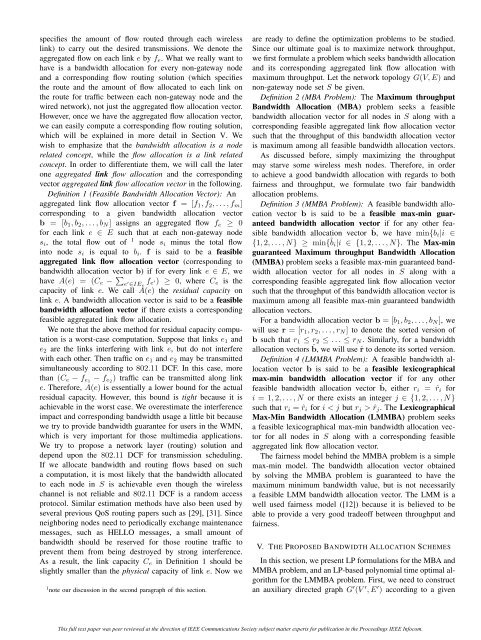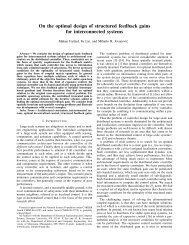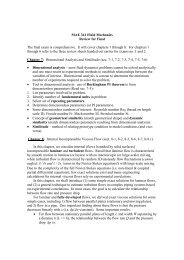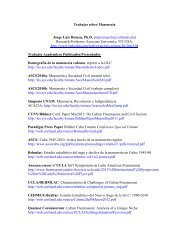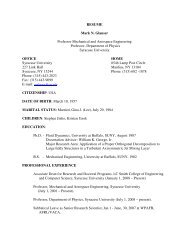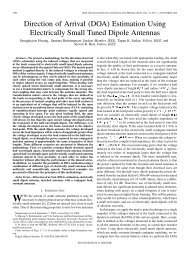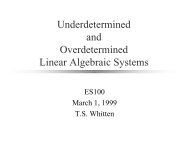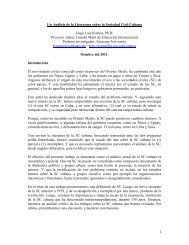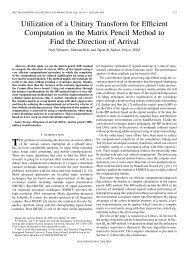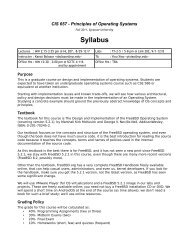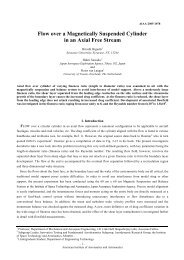Maximum Throughput and Fair Bandwidth Allocation in Multi ...
Maximum Throughput and Fair Bandwidth Allocation in Multi ...
Maximum Throughput and Fair Bandwidth Allocation in Multi ...
- No tags were found...
You also want an ePaper? Increase the reach of your titles
YUMPU automatically turns print PDFs into web optimized ePapers that Google loves.
specifies the amount of flow routed through each wirelessl<strong>in</strong>k) to carry out the desired transmissions. We denote theaggregated flow on each l<strong>in</strong>k e by f e . What we really want tohave is a b<strong>and</strong>width allocation for every non-gateway node<strong>and</strong> a correspond<strong>in</strong>g flow rout<strong>in</strong>g solution (which specifiesthe route <strong>and</strong> the amount of flow allocated to each l<strong>in</strong>k onthe route for traffic between each non-gateway node <strong>and</strong> thewired network), not just the aggregated flow allocation vector.However, once we have the aggregated flow allocation vector,we can easily compute a correspond<strong>in</strong>g flow rout<strong>in</strong>g solution,which will be expla<strong>in</strong>ed <strong>in</strong> more detail <strong>in</strong> Section V. Wewish to emphasize that the b<strong>and</strong>width allocation is a noderelated concept, while the flow allocation is a l<strong>in</strong>k relatedconcept. In order to differentiate them, we will call the laterone aggregated l<strong>in</strong>k flow allocation <strong>and</strong> the correspond<strong>in</strong>gvector aggregated l<strong>in</strong>k flow allocation vector <strong>in</strong> the follow<strong>in</strong>g.Def<strong>in</strong>ition 1 (Feasible B<strong>and</strong>width <strong>Allocation</strong> Vector): Anaggregated l<strong>in</strong>k flow allocation vector f = [f 1 ,f 2 ,...,f m ]correspond<strong>in</strong>g to a given b<strong>and</strong>width allocation vectorb = [b 1 ,b 2 ,...,b N ] assigns an aggregated flow f e ≥ 0for each l<strong>in</strong>k e ∈ E such that at each non-gateway nodes i , the total flow out of 1 node s i m<strong>in</strong>us the total flow<strong>in</strong>to node s i is equal to b i . f is said to be a feasibleaggregated l<strong>in</strong>k flow allocation vector (correspond<strong>in</strong>g tob<strong>and</strong>width allocation vector b) if for every l<strong>in</strong>k e ∈ E, wehave A(e) = (C e − ∑ e ′ ∈IE ef e ′) ≥ 0, where C e is thecapacity of l<strong>in</strong>k e. We call A(e) the residual capacity onl<strong>in</strong>k e. A b<strong>and</strong>width allocation vector is said to be a feasibleb<strong>and</strong>width allocation vector if there exists a correspond<strong>in</strong>gfeasible aggregated l<strong>in</strong>k flow allocation.We note that the above method for residual capacity computationis a worst-case computation. Suppose that l<strong>in</strong>ks e 1 <strong>and</strong>e 2 are the l<strong>in</strong>ks <strong>in</strong>terfer<strong>in</strong>g with l<strong>in</strong>k e, but do not <strong>in</strong>terferewith each other. Then traffic on e 1 <strong>and</strong> e 2 may be transmittedsimultaneously accord<strong>in</strong>g to 802.11 DCF. In this case, morethan (C e − f e1 − f e2 ) traffic can be transmitted along l<strong>in</strong>ke. Therefore, A(e) is essentially a lower bound for the actualresidual capacity. However, this bound is tight because it isachievable <strong>in</strong> the worst case. We overestimate the <strong>in</strong>terferenceimpact <strong>and</strong> correspond<strong>in</strong>g b<strong>and</strong>width usage a little bit becausewe try to provide b<strong>and</strong>width guarantee for users <strong>in</strong> the WMN,which is very important for those multimedia applications.We try to propose a network layer (rout<strong>in</strong>g) solution <strong>and</strong>depend upon the 802.11 DCF for transmission schedul<strong>in</strong>g.If we allocate b<strong>and</strong>width <strong>and</strong> rout<strong>in</strong>g flows based on sucha computation, it is most likely that the b<strong>and</strong>width allocatedto each node <strong>in</strong> S is achievable even though the wirelesschannel is not reliable <strong>and</strong> 802.11 DCF is a r<strong>and</strong>om accessprotocol. Similar estimation methods have also been used byseveral previous QoS rout<strong>in</strong>g papers such as [29], [31]. S<strong>in</strong>ceneighbor<strong>in</strong>g nodes need to periodically exchange ma<strong>in</strong>tenancemessages, such as HELLO messages, a small amount ofb<strong>and</strong>width should be reserved for those rout<strong>in</strong>e traffic toprevent them from be<strong>in</strong>g destroyed by strong <strong>in</strong>terference.As a result, the l<strong>in</strong>k capacity C e <strong>in</strong> Def<strong>in</strong>ition 1 should beslightly smaller than the physical capacity of l<strong>in</strong>k e. Nowwe1 note our discussion <strong>in</strong> the second paragraph of this section.are ready to def<strong>in</strong>e the optimization problems to be studied.S<strong>in</strong>ce our ultimate goal is to maximize network throughput,we first formulate a problem which seeks b<strong>and</strong>width allocation<strong>and</strong> its correspond<strong>in</strong>g aggregated l<strong>in</strong>k flow allocation withmaximum throughput. Let the network topology G(V,E) <strong>and</strong>non-gateway node set S be given.Def<strong>in</strong>ition 2 (MBA Problem): The <strong>Maximum</strong> throughputB<strong>and</strong>width <strong>Allocation</strong> (MBA) problem seeks a feasibleb<strong>and</strong>width allocation vector for all nodes <strong>in</strong> S along with acorrespond<strong>in</strong>g feasible aggregated l<strong>in</strong>k flow allocation vectorsuch that the throughput of this b<strong>and</strong>width allocation vectoris maximum among all feasible b<strong>and</strong>width allocation vectors.As discussed before, simply maximiz<strong>in</strong>g the throughputmay starve some wireless mesh nodes. Therefore, <strong>in</strong> orderto achieve a good b<strong>and</strong>width allocation with regards to bothfairness <strong>and</strong> throughput, we formulate two fair b<strong>and</strong>widthallocation problems.Def<strong>in</strong>ition 3 (MMBA Problem): A feasible b<strong>and</strong>width allocationvector b is said to be a feasible max-m<strong>in</strong> guaranteedb<strong>and</strong>width allocation vector if for any other feasibleb<strong>and</strong>width allocation vector ˆb, we have m<strong>in</strong>{b i |i ∈{1, 2,...,N} ≥ m<strong>in</strong>{ˆb i |i ∈ {1, 2,...,N}. The Max-m<strong>in</strong>guaranteed <strong>Maximum</strong> throughput B<strong>and</strong>width <strong>Allocation</strong>(MMBA) problem seeks a feasible max-m<strong>in</strong> guaranteed b<strong>and</strong>widthallocation vector for all nodes <strong>in</strong> S along with acorrespond<strong>in</strong>g feasible aggregated l<strong>in</strong>k flow allocation vectorsuch that the throughput of this b<strong>and</strong>width allocation vector ismaximum among all feasible max-m<strong>in</strong> guaranteed b<strong>and</strong>widthallocation vectors.For a b<strong>and</strong>width allocation vector b =[b 1 ,b 2 ,...,b N ],wewill use r =[r 1 ,r 2 ,...,r N ] to denote the sorted version ofb such that r 1 ≤ r 2 ≤ ... ≤ r N . Similarly, for a b<strong>and</strong>widthallocation vectors ˆb, we will use ˆr to denote its sorted version.Def<strong>in</strong>ition 4 (LMMBA Problem): A feasible b<strong>and</strong>width allocationvector b is said to be a feasible lexicographicalmax-m<strong>in</strong> b<strong>and</strong>width allocation vector if for any otherfeasible b<strong>and</strong>width allocation vector ˆb, either r i = ˆr i fori =1, 2,...,N or there exists an <strong>in</strong>teger j ∈{1, 2,...,N}such that r i =ˆr i for i ˆr j .TheLexicographicalMax-M<strong>in</strong> B<strong>and</strong>width <strong>Allocation</strong> (LMMBA) problem seeksa feasible lexicographical max-m<strong>in</strong> b<strong>and</strong>width allocation vectorfor all nodes <strong>in</strong> S along with a correspond<strong>in</strong>g feasibleaggregated l<strong>in</strong>k flow allocation vector.The fairness model beh<strong>in</strong>d the MMBA problem is a simplemax-m<strong>in</strong> model. The b<strong>and</strong>width allocation vector obta<strong>in</strong>edby solv<strong>in</strong>g the MMBA problem is guaranteed to have themaximum m<strong>in</strong>imum b<strong>and</strong>width value, but is not necessarilya feasible LMM b<strong>and</strong>width allocation vector. The LMM is awell used fairness model ([12]) because it is believed to beable to provide a very good tradeoff between throughput <strong>and</strong>fairness.V. THE PROPOSED BANDWIDTH ALLOCATION SCHEMESIn this section, we present LP formulations for the MBA <strong>and</strong>MMBA problem, <strong>and</strong> an LP-based polynomial time optimal algorithmfor the LMMBA problem. First, we need to constructan auxiliary directed graph G ′ (V ′ ,E ′ ) accord<strong>in</strong>g to a givenThis full text paper was peer reviewed at the direction of IEEE Communications Society subject matter experts for publication <strong>in</strong> the Proceed<strong>in</strong>gs IEEE Infocom.


